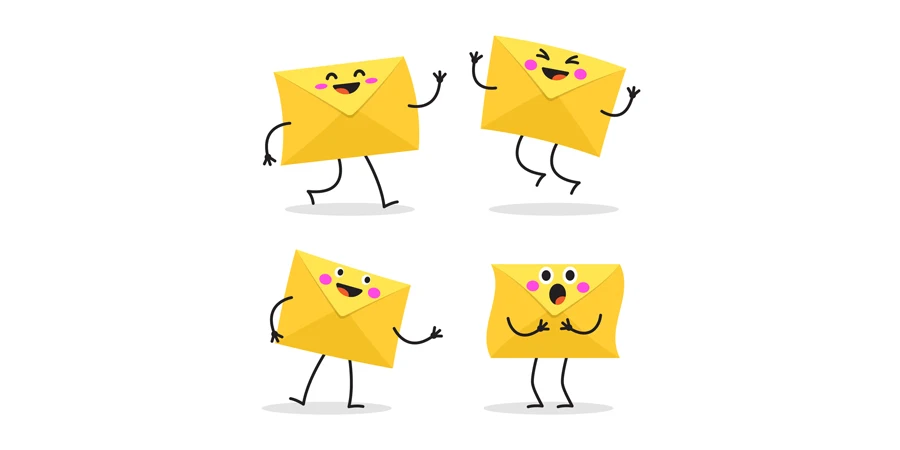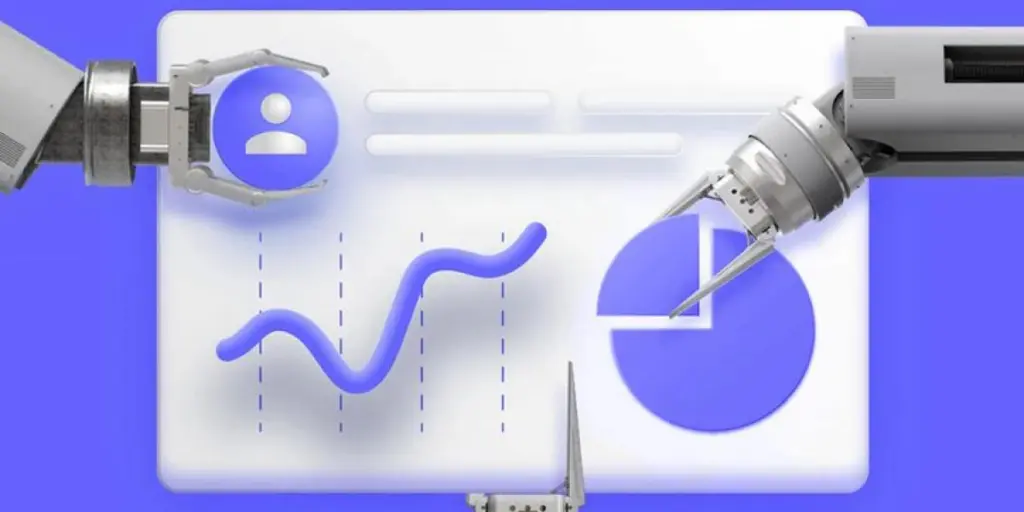What do you call a chicken crossing the road?
Poultry in motion!
Ba-dum-tiss!
Okay, it’s not the greatest joke, but let’s skip to the serious bit: funny emails lighten the mood and can make business communications more engaging. They can also be a great way to make your brand more personable, and they can help to make dull subjects more appealing.
But learning how to write funny emails involves more than just a clever joke or a witty remark. It’s about maintaining the perfect balance between humor and professionalism to ensure the message is entertaining and appropriate for its intended audience.
We’ll explore 10 examples of funny emails that have struck the right chord. These examples will inspire you to add a dash of humor to your emails, making them more effective and entertaining.
In this article, you’ll find funny email examples in the following categories:
1. Funny subject line
2. Funny greeting
3. Funny email template
4. Funny newsletter
5. Funny cold email
6. Funny onboarding email
7. Funny cart abandonment email
8. Funny promotional email
9. Funny re-engagement email
10. Funny apology email
1. Example of a funny subject line
Crafting funny emails involves using wit and creativity to create a strong first impression.
Funny email subject lines not only grab attention but can also set a light-hearted tone for your content. By making your emails funny right from the subject line, you can evoke curiosity and get recipients to open and engage with your message.
Consider this playful subject line by Nood. It makes you smile and wonder what this comparison would mean. Readers can’t resist opening the email to find out more.

Here are some practical tips for creating humorous subject lines:
- Keep it short: Subject lines should be concise yet impactful. Aim to keep them under 50 characters so they’re displayed fully on most email platforms and devices.
- Know your audience: Humor can be subjective. Make sure that your funny subject lines align with your audience’s tastes and preferences.
- Use emojis: Using emojis in a subject line can increase visual appeal. This can also make it more relatable than plain text.
2. Example of funny greetings for emails
Using humor in email greetings can be a great way to grab your audience’s attention and set a positive tone from the get-go.
Funny greetings for emails can make the reader more receptive to the rest of the email message. They can show your audience that you’re approachable and friendly rather than overly formal. This helps create a sense of camaraderie and connection with your recipient.
Plus, humorous messages are more likely to be remembered. That’s why they help build strong relationships with your existing and potential customers.
The email greeting “Howdy, Outsiders!” by Kammok is a humorous and playful way to address its subscribers. It establishes a friendly tone between the brand and its customers, who share a love for the outdoors.
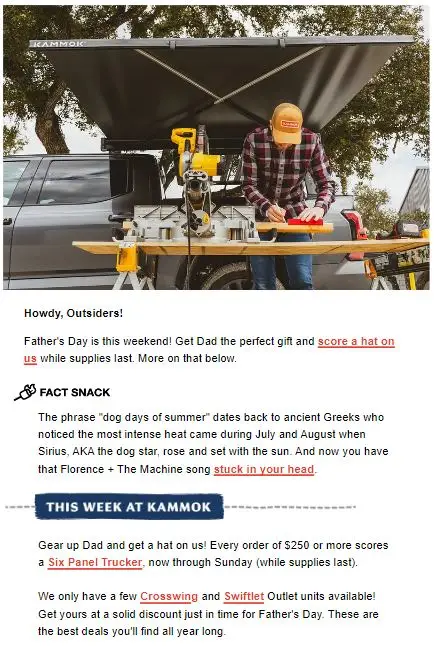
However, you should remember that the appropriateness of humor in emails can vary depending on the context and audience. Tailor your funny greetings for emails to fit the context, whether it’s for business or casual communications.
3. Example of a funny email template
Instead of creating email campaigns from scratch, you can use funny email templates to incorporate humor into your strategy.
This template by Omnisend subtly induces humor. It features a charming cat looking to be shocked, alongside a catchy headline that grabs the user’s attention.
While the email is funny, it doesn’t lose its primary purpose: the template has a section to feature your top recommendations and add multiple CTA buttons. Any pet products brand can use this template for free and design a campaign for their upcoming sale.

4. Example of a funny newsletter
Humor can turn a mundane newsletter into a delightful read. With humor, you can break through the clutter of serious and promotional emails and encourage readers to look forward to your messages.
Here’s how humor can enhance the appeal of your newsletter:
- Builds connection: A well-timed joke or playful language can make your message more relatable. Humor can make complex information more digestible, effectively increasing engagement rates.
- Encourages sharing: Funny content is more likely to be shared. This can extend your reach organically.
- Re-engage inactive subscribers: A touch of humor can pique your subscribers’ interest. Maybe they stopped opening your newsletters because they felt they knew what to expect. Adding humor can make them wonder what other surprises await them
This newsletter by Radim Malinic uses humorous descriptions to make the newsletter a catchy read. The email takes a universal experience (finding motivation or inspiration) and adds a humorous twist by personifying it through the idea of anonymous superheroes.

Creating funny email newsletters requires a balance of humor and valuable content. Here are a few tips to help you get it right:
- Keep the humor relatable: Tailor your humor to fit your audience’s preferences. People enjoy humor that reflects their own experiences. Incorporate common frustrations or quirky observations related to your industry.
- Strike the right balance: Ensure your newsletter maintains a professional tone while injecting humor strategically. Balance light-heartedness with informative or actionable content to keep your readers engaged. You can explore various newsletter templates to create funny newsletters that integrate humor and promotional messages effectively.
- Use creative CTAs: Spice up your CTAs with a playful, humorous twist. Instead of the standard “Click here” or “Learn more,” try something more creative and attention-grabbing that adds a playful touch while encouraging action.
- Include lively designs and visuals: Visual elements can convey messages more effectively than text alone. Incorporate lively designs, GIFs, or humorous illustrations that complement your content. Ensure your newsletter design aligns with your brand’s identity.
5. Example of a cold email
A cold email is an unsolicited email sent to a prospect who hasn’t interacted with your brand yet. Cold emailing is a common tactic used to generate leads or build brand awareness.
They are often perceived as being dry and unengaging, but they don’t have to be. Humor can create a more positive and friendly tone for these emails to make the recipient more receptive.
You can use these strategies to make your cold emails fun and engaging:
- Tell a story: Stories can capture interest. Use a humorous narrative in your cold email to tell a story that leads into your pitch. This makes your email more interesting than a straightforward pitch.
- Use self-deprecating humor: Poking fun at the awkwardness of cold emails can be an effective icebreaker. Acknowledge the impersonal nature of your outreach and make a lighthearted joke about it. This shows self-awareness and can help build rapport.
- Use wordplay or puns: Clever puns or wordplay can be effective in injecting humor into your cold emails. Paint a playful picture with your words. Describe scenarios or metaphors that evoke a smile or chuckle. Just be sure to keep them lighthearted and relevant to your offering.
Consider this cold email example from Beefree. The copy is written in a conversational, friendly tone with a clever play on words to inject humor. For instance, describing her old inspiration inbox as “a little embarrassing” and admitting she’s “old enough” to have done so gives a self-deprecating, humorous tone that its target audience can appreciate.

6. Example of an onboarding email
First impressions matter, and this is especially true when welcoming new customers. The onboarding process is your chance to create a positive experience that sets the stage for long-term engagement.
A dry, technical email filled with instructions can leave users feeling overwhelmed and unsure of how to proceed. If they find your emails funny, they’re more likely to want to keep reading about what you have to offer.
The best welcome emails strike a balance between being informative and fun. This can create a memorable first impression that gets new subscribers excited about what the brand has to offer.
Consider using these tips to set a fun and welcoming tone for your onboarding emails:
- Personalize the email: Use the customer’s name in the greeting to create a more personal connection right from the start
- Use a humorous subject line: A playful and upbeat subject line can instantly create a light-hearted tone
- Use a catchy introduction: Start your email with a playful introduction that includes humor related to your industry or product to set the right tone
- Include humorous visuals: Incorporate visuals like GIFs, memes, or illustrations to add humor and visual interest to your brand
This onboarding email from Sea of Thieves is a prime example of using humor and a strong thematic style to welcome new users. It features vibrant and adventurous visuals to capture the essence of the game. The copy is filled with pirate lingo and humorous phrases that fit the game’s theme. Puns, jokes, and playful language keep the tone light and fun.

7. Example of a cart abandonment email
Cart abandonment is a common issue for ecommerce businesses. You need effective solutions to re-engage these users and capture lost revenue.
Since recipients are more likely to open funny emails, incorporate humor in your cart abandonment emails to increase open rates and get them to complete their purchases.
Let’s take a look at some cart abandonment email best practices you can follow to achieve good results.
- Use high-converting subject lines: Of course, even the funniest cart abandonment email copy won’t be effective if it doesn’t get opened in the first place. That’s why it’s important to write attention-grabbing, high-converting subject lines that pique the customer’s curiosity and make them want to click.
- Tie your humor to the context of the email: In cart abandonment emails, you must focus on the items left behind. For example, you can create funny scenarios or personifications of these items to capture the reader’s interest.
- Create a series of trigger emails: A single cart abandonment email might not be enough to bring a customer back. By creating a series of trigger emails, you can gradually build urgency and provide additional incentives to encourage the customer to complete their purchase.
- Include easy-to-find CTAs: Even with humor, the goal is to guide the customer back to their cart. Make sure your call to action stands out and clearly tells the reader what to do next. Use engaging, playful phrases that align with the tone of your email.
Through its humorous tone, TargetBay grabs the recipient’s attention with this cart abandonment email. The brand pokes a little fun at the situation, suggesting that the recipient has been caught looking at the products.
Also, the use of urgency, noting that the products are in hot demand, creates a sense of FOMO and encourages action from the recipient.
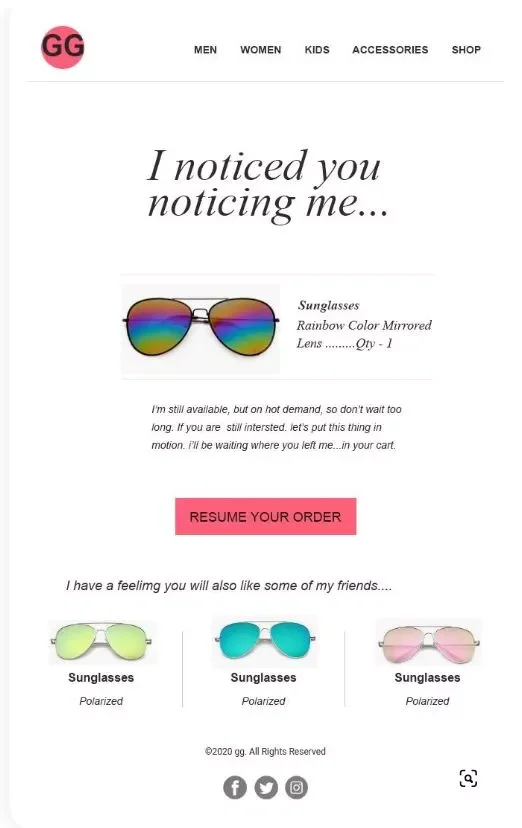
8. Example of a promotional email
Like other marketing channels, the ultimate goal of email marketing is to promote your business and generate more revenue. Promotional emails contain special offers, discounts, or new product releases designed to entice customers to take action.
Adding a dash of humor to promotional emails can make them seem more conversational and less salesy. Here’s how to do this:
- Use witty subject lines: Start with a clever subject line that uses wordplay or puns
- Adopt storytelling: Include a humorous anecdote or relatable story to introduce your promotion while entertaining your readers
- Incorporate interactive elements: This can include funny quizzes, polls, or games to encourage participation
This email by Parla is a model example of how to write funny emails. It uses wit and storytelling to successfully market its products. The email maintains a humorous tone throughout, using playful language and witty scenarios related to bathroom habits to engage the reader. The content is concise, focusing on how the product benefits users in everyday situations.

9. Example of a re-engagement email
Re-engagement emails, also called reactivation emails, are often used to rekindle interest among inactive subscribers.
The goal is to drive them towards making a purchase or engaging with your content once again. Making your emails funny is a creative and effective approach for re-engagement emails.
A funny and effective re-engagement email strikes a balance between relevance and humor. While the goal is to make the receiver smile and get their attention, the content should also be significant and consistent with your brand identity.
This re-engagement email from New Look grabs attention with its humorous tone. It draws the reader in with a bit of friendly banter, encouraging them to engage with the brand.
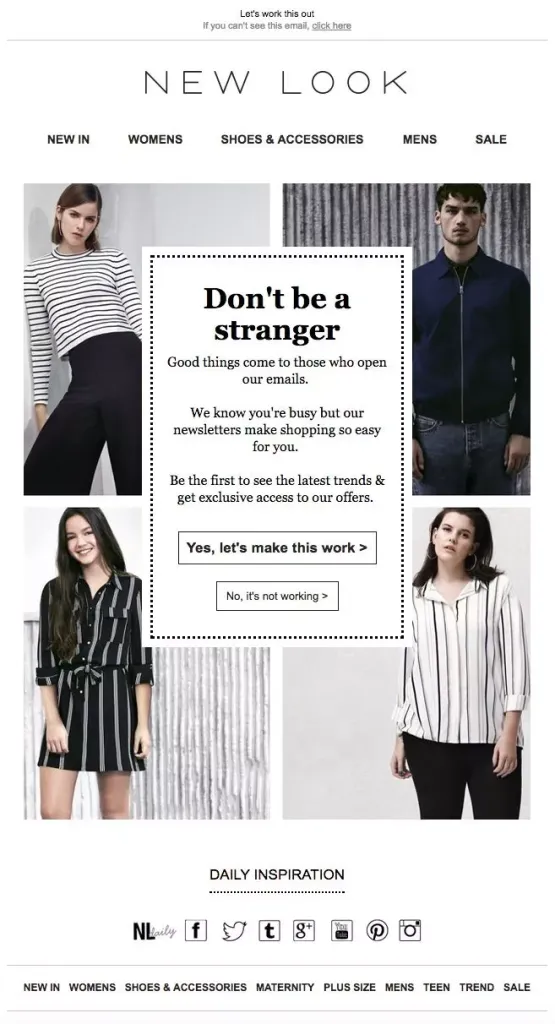
10. Example of an apology email
Mistakes are inevitable in business interactions, and businesses can find themselves needing to apologize to their customers. Funny emails may not always be appropriate, and you may need to opt for a formal, professional apology instead. However, sometimes, bringing in a touch of humor can show a more human and relatable side of the brand.
To create an effective funny apology email, you typically need to follow this structure:
- Acknowledge the mistake: Start by clearly and directly addressing the issue at hand. Don’t try to sugarcoat or downplay the problem. Own up to it and take responsibility. You can use a lighthearted tone to help diffuse the tension.
- Express genuine remorse: Convey your sincere apologies for the inconvenience or frustration caused. Empathize with the customer’s experience and let them know you understand how they must be feeling.
- Offer a solution: Outline the steps you’re taking to resolve the issue and make things right. Provide a clear plan of action and timeline, if possible.
This apology email from Methodical Coffee stands out as it uses a lighthearted tone to apologize to subscribers. Firstly, it opens with a clear and concise subject line, immediately indicating the purpose of the message.
Despite it not being a formal apology, the tone of the email remains direct and respectful, taking full responsibility for the error without making excuses.
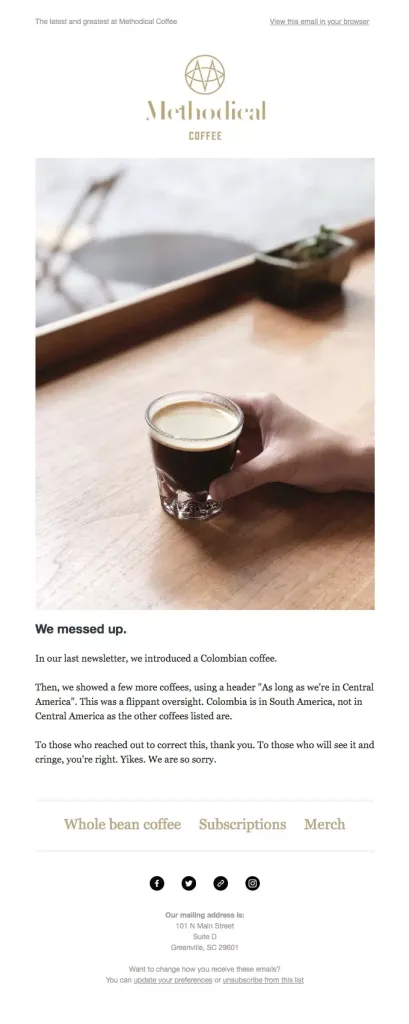
Considerations before making your emails funny
Incorporating humor in your email campaigns can effectively engage your audience. However, it’s crucial to consider several factors before using humor to ensure that your message resonates with your recipients. These factors include:
Your target audience
Humor can be subjective. One person may find your emails funny, another might find them offensive. Before you decide to add a comical twist to your emails, consider the sensitivity, context, and cultural differences of your audience.
It’s essential to segment your audience effectively based on their demographics, interests, and previous interactions with your brand to better understand them.
By knowing your audience, you can better gauge their sense of humor and avoid potential misunderstandings or offenses.
Brand voice
Your brand voice is the personality and emotion infused into your company’s communication. It sets the tone for how your audience perceives you and interacts with your content.
Humor can be a powerful tool for email branding, but it needs to feel genuine and should reinforce your brand identity.
So remember, when thinking of funny emails, ensure the humor aligns with your brand voice and personality. Doing so will help maintain a consistent and trustworthy brand image through your emails. This is crucial for building and sustaining strong customer relationships.
Content structure
Just like any kind of email, interesting content is important for funny emails. To integrate humor naturally into your emails, it’s essential to structure your content effectively. This involves creating a clear and concise message that’s easy to follow through all email sections.
- Subject line: Try using puns, wordplay, or a humorous observation that relates to your email’s content
- Greeting: Instead of the standard “Dear customer,” try a more playful approach or a humorous salutation
- Email copy: An anecdote or a witty remark related to the subject matter can make the content more engaging
- Visuals: Humor can be incorporated through images, GIFs, or even emojis that complement the message
- CTAs: Use playful, action-oriented language that can encourage engagement
Testing
Before sending out funny emails to your entire audience, you should test them on smaller segments of your audience.
Conducting email A/B testing allows you to gauge how your audience will respond to your email and make adjustments as needed.
This way, you don’t run the risk of offending recipients. You’ll also ensure that your email campaigns are optimized for better results.
Risks
There are potential risks involved in making your emails funny. The most significant risk is that your humor may offend some recipients.
This can damage your brand’s reputation and lead to a loss of trust. To mitigate these risks, be mindful of your audience’s sensitivities and cultural differences.
Ensure that your humor is respectful and doesn’t cross any boundaries. Additionally, be prepared to apologize if your humor is misinterpreted and adjust your approach accordingly.
Conclusion
Funny emails can effectively lighten the mood and make your business communications more engaging and memorable.
We’ve discussed the most prominent categories of examples and how humor can be successfully included in these emails to impress your recipients. The examples we analyzed should give you some idea of how to be witty and professional at the same time.
Go ahead and add a splash of humor in your next email campaign to connect with your audience and bring a smile to their faces.
Source from Omnisend
Disclaimer: The information set forth above is provided by omnisend.com independently of Alibaba.com. Alibaba.com makes no representation and warranties as to the quality and reliability of the seller and products.
